R
Rösti
Unconfirmed Member
Example image of setup
On August 3, 2015, Sony Computer Entertainment Europe Limited filed in the US via the USPTO a trademark application for "Computer Controlled Furniture and Method". It is originally a UK filing dating from 2014, but it was published in the US today on February 18, 2016. Inventor is Andy Thomason (Goldsmiths & Sony).
The title of the patent is quite straightforward as the idea/innovation deals with ways to control furniture (a chair, sofa, care bed etc.) using a computer (video game console, PC or the like). It's not a lengthy patent either, so the majority of it should fit in this post. As usual, interesting parts in bold. To begin with, here is the abstract:
Abstract
A re-configurable item of furniture is provided, and includes at least a first reconfigurable portion having in turn a plurality of deformable cells, each having electrically operated valves to control a gas inflow to the respective cells from a gas inflow source, and a gas outflow from the respective cells, to thereby modify the pressure within respective cells. The gas inflow source includes a high-pressure reservoir cell among the plurality of deformable cells. The item of furniture also includes a control unit arranged to transmit control signals to a plurality of the electrically operated valves, including a valve of the high-pressure reservoir cell, to modify the pressure within a plurality of the cells in a coordinated manner selected to generate a new configuration of support for a user of the furniture.
Claims
1. A re-configurable item of furniture, comprising: at least a first reconfigurable portion comprising in turn: a plurality of deformable cells, each respective one of the plurality of deformable cells having electrically operated valves to control a gas inflow to the respective cells from a gas inflow source, and a gas outflow from the respective cells, to thereby modify a pressure within respective cells; and a control unit arranged to transmit control signals to a plurality of the electrically operated valves to modify the pressure within a plurality of the cells in a coordinated manner selected to generate a new configuration of support for a user of the furniture; and wherein the gas inflow source comprises a high-pressure reservoir cell among the plurality of deformable cells.
2. A re-configurable item of furniture according to claim 1, in which the first reconfigurable portion comprises an array of the deformable cells arranged to occupy a seating area to be sat on by a user.
3. A re-configurable item of furniture according to claim 1, in which the gas inflow source is supplied by an air compressor.
4. A re-configurable item of furniture according to claim 3, in which the gas outflow from one or more of the respective cells leads to an input to the air compressor.
5. A re-configurable item of furniture according to claim 1, in which for one or more of the respective cells, the electrically operated valve controlling gas inflow to the one or more respective cells directly couples the one or more respective cells to the high-pressure reservoir cell.
6. A re-configurable item of furniture according to claim 1, in which a plurality of the electrically operated valves share a common power line, and open or close in response to instructions associated with respective IDs.
7. A re-configurable item of furniture according to claim 1, comprising: at least a first high tension flexible restraint arranged to limit expansion of a portion of the item of furniture beyond a certain set extent.
8. A re-configurable item of furniture according to claim 1, in which the coordinated modification of pressure within the plurality of cells is selected so as to increase pressure in a cell that rises above the seating area and is located in a direction to which the new configuration of support will tilt a user of the furniture.
9. A re-configurable item of furniture according to claim 1, comprising: a padded rigid seating unit positioned on top of cells in a seating area of the chair, the padded rigid seating unit comprising an accelerometer operable to indicate a direction and amount of tilt of the padded rigid seating unit.
10. A re-configurable item of furniture according to claim 1, in which the control unit comprises: a receiver; and is arranged in operation to receive instructions representative of the new configuration of support from a remote device.
11. A remote device, comprising: instruction processing means operable to generate, responsive to current visual content being output by the remote device, instructions representative of a new configuration of support for a reconfigurable item of furniture that in turn comprises at least a first reconfigurable portion comprising in turn a plurality of deformable cells, each respective one of the plurality of deformable cells having electrically operated valves to control a gas inflow to the respective cells from a gas inflow source, and a gas outflow from the respective cells, to thereby modify a pressure within respective cells, wherein the gas inflow source comprises a high-pressure reservoir cell among the plurality of deformable cells; and a transmitter operable to transmit the generated instructions to the reconfigurable item of furniture.
12. A method of reconfiguring an item of furniture comprising at least a first reconfigurable portion comprising in turn a plurality of deformable cells, each respective one of the plurality of deformable cells having electrically operated valves to control a gas inflow to the respective cells from a gas inflow source, and a gas outflow from the respective cells, to thereby modify a pressure within respective cells, wherein the gas inflow source comprises a high-pressure reservoir cell among the plurality of deformable cells, the item of furniture also comprising a control unit, the method comprising the steps of: receiving instructions representative of a new configuration of support from a remote device; and transmitting control signals to a plurality of the electrically operated valves, including a valve of the high-pressure reservoir cell, to modify the pressure within given ones of the cells in a coordinated manner selected to generate the new configuration of support for a user of the furniture.
13. A method of reconfiguring an item of furniture that comprises at least a first reconfigurable portion comprising in turn a plurality of deformable cells, each respective one of the plurality of deformable cells having electrically operated valves to control a gas inflow to the respective cells from a gas inflow source, and a gas outflow from the respective cells, to thereby modify a pressure within respective cells, wherein the gas inflow source comprises a high-pressure reservoir cell among the plurality of deformable cells, the method comprising the steps of: generating at a remote device instructions representative of a configuration of support for the item of furniture, responsive to current visual content being output by the remote device; and transmitting the generated instructions to a control unit of the reconfigurable item of furniture.
14. A non-transitory computer program product comprising a tangible computer readable medium storing computer instructions thereon, the computer instructions adapted to cause a computer to carry out a method of: reconfiguring an item of furniture that comprises at least a first reconfigurable portion comprising in turn a plurality of deformable cells, each respective one of the plurality of deformable cells having electrically operated valves to control a gas inflow to the respective cells from a gas inflow source, and a gas outflow from the respective cells, to thereby modify a pressure within respective cells, wherein the gas inflow source comprises a high-pressure reservoir cell among the plurality of deformable cells, the reconfiguring step in turn comprising the steps of: generating instructions representative of a configuration of support for the item of furniture, responsive to current visual content being output by the remote device; and transmitting the generated instructions to a control unit of the reconfigurable item of furniture.
BACKGROUND OF THE INVENTION
[0001] 1. Field of the Invention
[0002] The present invention relates to computer controlled furniture and a corresponding method of control.
[0003] 2. Description of the Prior Art
[0004] The "background" description provided herein is for the purpose of generally presenting the context of the disclosure. Work of the presently named inventors, to the extent it is described in this background section, as well as aspects of the description which may not otherwise qualify as prior art at the time of filing, are neither expressly or impliedly admitted as prior art against the present invention.
[0005] Computer-controlled furniture was originally integrated into arcade videogame cabinets to provide players with physical feedback in response to on-screen action. Subsequently force feedback chairs have been developed for use with home game consoles and PCs. Both the videogame cabinets and force feedback chairs traditionally use combination of motors and hydraulics to move, thereby giving the illusion of motion to the user. For example in a driving game when the user causes their car to brake, the force feedback chair tilts forward as if the car is braking.
[0006] As noted above, these chairs typically use a combination of servo motors and hydraulic or pneumatic pistons or rams. As a result, typically they are expensive and bulky.
[0007] Furthermore, recent advancements in virtual reality displays means that the users of such chairs are now likely to also be wearing a virtual reality headset, and as a result cannot see where their hands are in relation to moving components of such a chair. As a result there is a risk of injury if for example hands or fingers are trapped by moving components of the chair.
[0008] The present invention aims to alleviate or mitigate the above problems.
Drawings
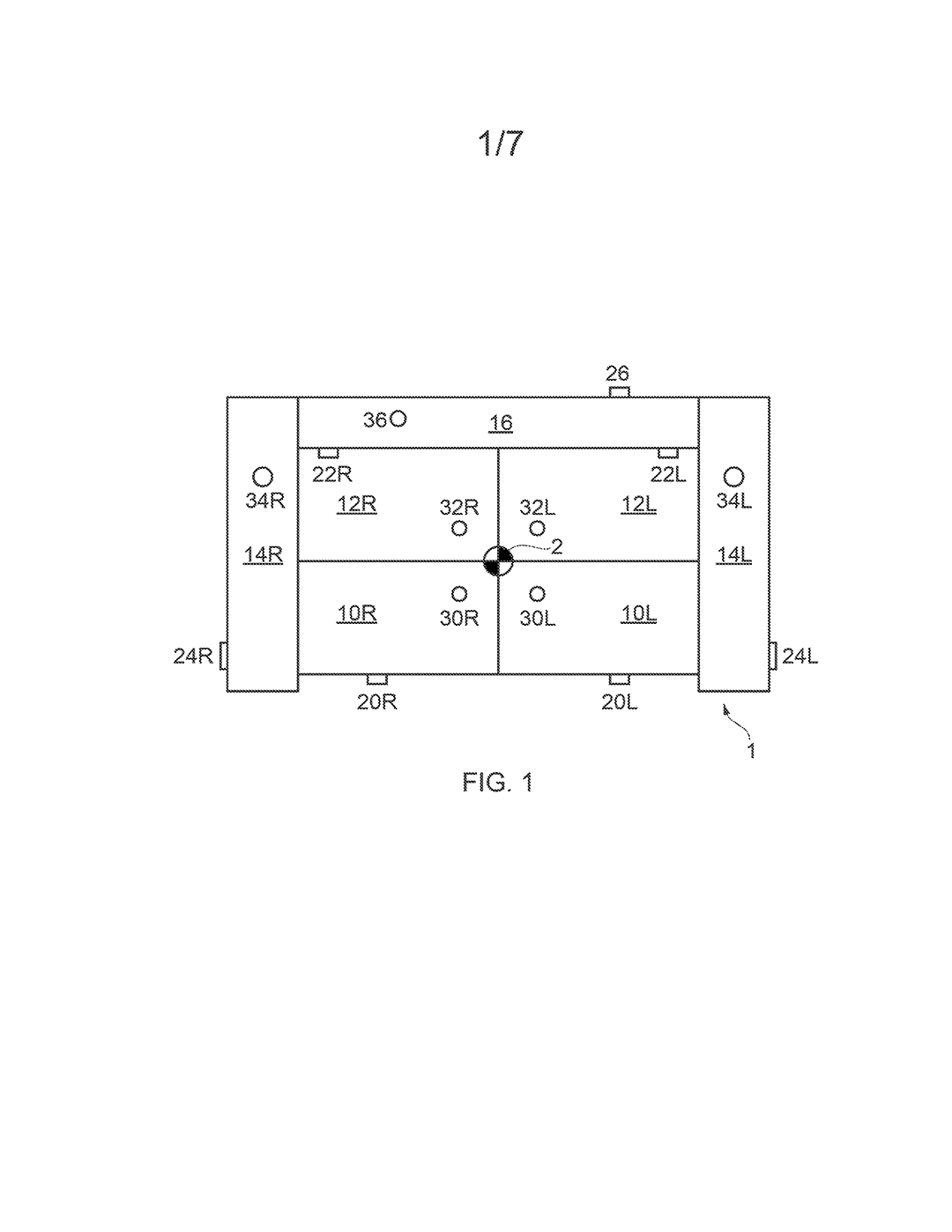
[0015] FIG. 1 is a schematic diagram of a plan view of a reconfigurable item of furniture in accordance with embodiments of the present invention.
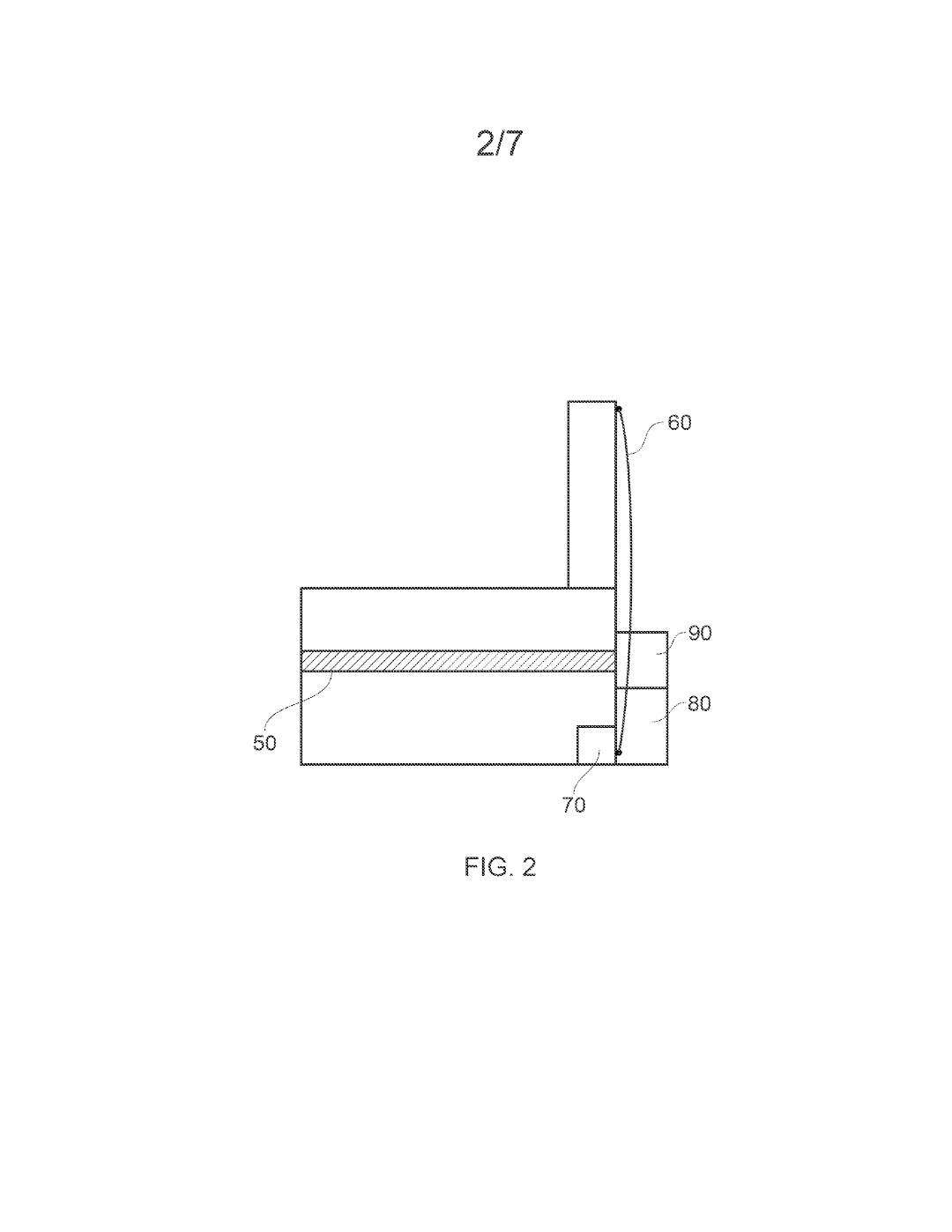
[0016] FIG. 2 is a schematic diagram of a side view of a reconfigurable item of furniture in accordance with embodiments of the present invention.

[0017] FIGS. 3A-C are schematic diagrams of outflow arrangements in accordance with embodiments of the present invention.
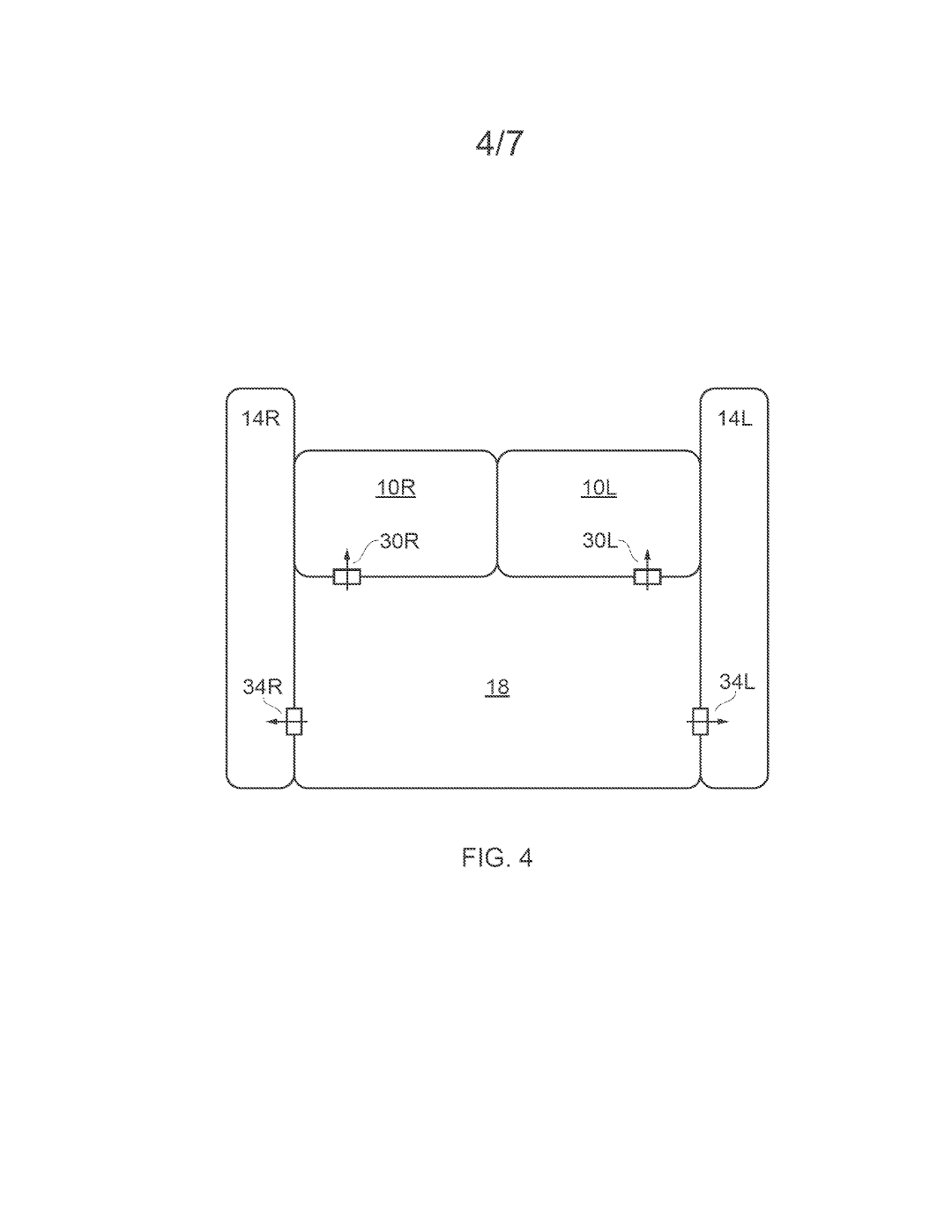
[0018] FIG. 4 is a schematic diagram of an inflow arrangement in accordance with embodiments of the present invention.
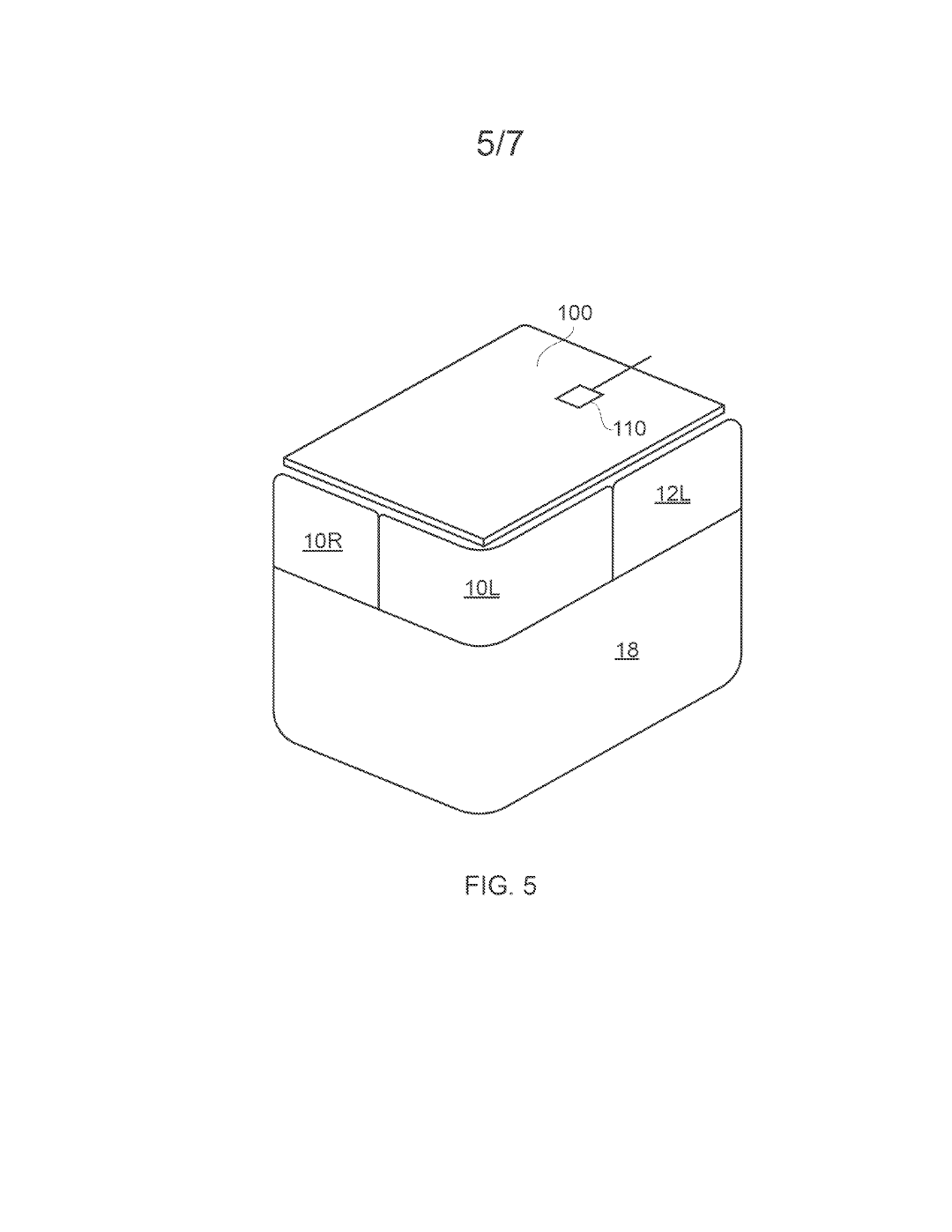
[0019] FIG. 5 is a schematic diagram of a partial isometric view of a reconfigurable item of furniture in accordance with embodiments of the present invention.
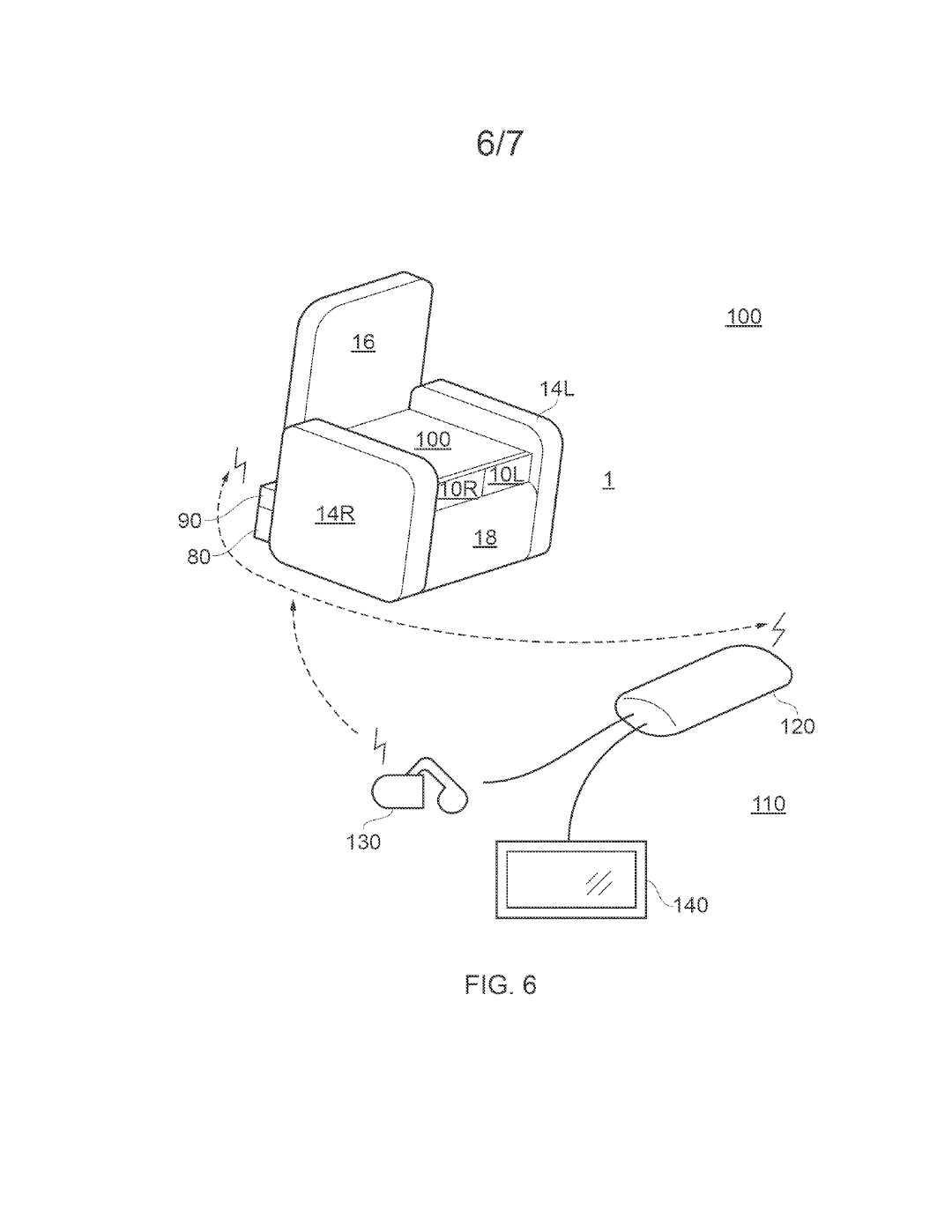
[0020] FIG. 6 is a schematic diagram of a system in accordance with embodiments of the present invention.

[0021] FIG. 7 is a flow diagram of a method of reconfiguring out of the furniture in accordance with embodiments of the present invention.
[0022] FIG. 8 is a flow diagram of a method of reconfiguring out of the furniture in accordance with embodiments of the present invention.
The patent then goes into great length describing the structure of the furniture. All of it I won't quote, but here are some excerpts:
[0024] Referring now to FIG. 1, which is a plan view of a chair, in an embodiment of the present invention an item of furniture (1) such as for example the illustrated chair is constructed at least in part from a plurality of inflatable cells (10R,L; 12R,L). The cells may be made from vinyl, PVC, or any suitable airtight deformable material to allow the cells to deform in response to the combination of their internal pressure and the force applied to them by a user of the chair sitting in it. It will be appreciated that the configuration of cells in FIG. 1 is non-limiting.
[0062] Each solenoid valve in the chair is electrically coupled to a control unit (90), for example by wire. Wires may be effectively channelled between actuator cells. For example the wires controlling solenoid valves between a high-pressure reservoir 18 and front actuator cells (10R,L) may be channelled through a gap between these three cells to the back of the chair. Wires for other solenoid valves may make use of this or other gaps between actuator cells.
[0069] In an embodiment of the present invention, the control unit comprises a wired or wireless receiver (such as a Bluetooth.RTM. receiver, Wi-Fi.RTM. receiver or infrared receiver), operable to receive control signals from a remote device such as a video game console, PC or the like, and uses these control signals to operate the solenoid valves accordingly. Hence for example the control signals may comprise packets with a payload comprising a binary pattern in which each bit corresponds to a valve within the chair, the pattern indicating which valves should be open or shut at a given moment. In this way timing for control of the solenoid valves is provided.
[0075] Optionally in this embodiment the padded rigid seating unit may comprise one or accelerometers (110) to provide tilt feedback signals to the control unit. In this instance, the control unit may be equipped to receive signals from the console, media player or the like to tilt the user by a certain angle rather than receive signals controlling each solenoid, and then the control unit itself can control the solenoids to tilt the user responsive to the feedback signals from the padded rigid seating unit. Alternatively the feedback signals from the padded rigid seating unit can be transmitted back to the console, media player or the like, which can update the signals it transmits controlling each solenoid.
Variations
[0080] It will be appreciated that the example of a chair using the above description is non-limiting, and may for example also apply to a sofa comprising two or three seating areas with respective sets of actuator cells. In this case, different seats may be associated with different players of the game, and respective players may be identified for example by suitable activation of a button on a controller or by suitable movement gesture by a head mounted display in response to a prompt from the console.
[0081] Similarly the chair or sofa may also include other pressure configurable features, such as a footrest comprising a wedge shaped cell located at the lower front of the chair that can be inflated to provide additional support for the user's lower legs. Such a cell may use a resilient material will be constrained by resilient strap, so that upon deflation it automatically returns to earn unobtrusive stowed position flush to the front of the chair. Similar cells may be provided at the back of the chair; In this case for example a wedge shaped cell may be inflated by default, and deflated to cause the chair back to recline.
[0082] Similarly a conventional chair or sofa may be retrofitted with a minimal implementation of just the actuator cells for a seat, such as cells 10R,L and 12R,L, or any equivalent array of such cells as described previously, optionally together with the padded rigid seating unit described previously. For example this intimidation may take the form of a replacement padded seating cushion which can be swapped for one provided with the conventional chair or sofa. In conjunction with a compressor and control unit as described previously, this would allow a user to enjoy some of the benefits of the full chair if they do not have space to inflate the chair, or have placed a preferred conventional chair or sofa at a specific position with respect to television, speakers etc., and do not wish to move it to make space for the full chair. Typically such a retrofit would be less responsive as it may not comprise a high-pressure reservoir cell, and because it may be necessary to use smaller or flatter actuator cells in order to fit safely within a conventional chair. It will be appreciated that different versions of such a retrofit could be offered with greater or fewer cells (for example also including a back cell) and/or with cells having greater or lesser volume.
[0083] Similarly the furniture need not be limited to entertainment functions. Hence in a separate embodiment, a care bed for domestic or hospital use may be equipped with a combination of actuator cells allowing inflation to raise a head end of the bed in conjunction with deflation to lower a central portion of the bed to a preferred level set by the user, to assist them with getting in and out of bed. The rate and extent of inflation and deflation of the respective cells can be set by the user and controlled by a control unit of the bed or, for example via a smartphone application providing an intuitive interface for the user; the smart phone can communicate with the control unit using Bluetooth .RTM. or similar as described previously. Again, such a bed may include suitably placed accelerometers to provide tilt feedback to the control unit or smart phone application.
Summary
Source: Search 14/816537 here[0096] In a summary embodiment of the present invention, a remote device (such as a video game console, set-top box, smart TV, media player or the like) comprises instruction processing means (such as a CPU) operable to generate instructions representative of a new configuration of support for a reconfigurable item of furniture, responsive to current visual content being output by the remote device (for example a videogame, TV or film, accessing complimentary configuration metadata if necessary), and also comprises a transmitter operable to transmit the generated instructions to the reconfigurable item of furniture (as noted above for example Bluetooth.RTM., Wi-Fi.RTM. or infrared).
As always, a patent application is not evidence of a product being developed. But there you have it. Would you be interested in something like this?


